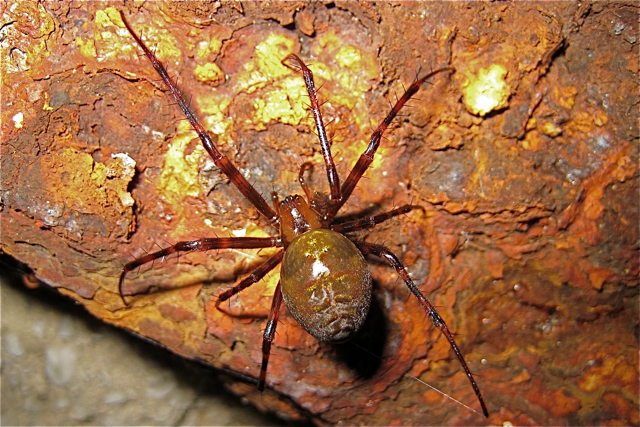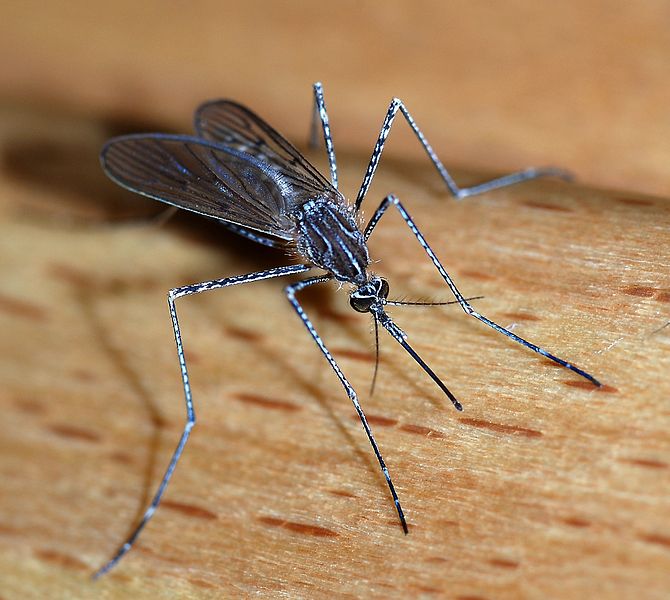
Adaptation
Meta menardi
has varied body lengths based on sex.
Male European Cave Spiders range from 9.9 to 12.6 mm in
body length and are smaller than the females who range from 12.9
to 15 mm in body length (Fritzén
and Koponen 2011).
Their coloration is mainly dark colors, the cephalothorax is
reddish brown, and the abdomen and long legs are usually dark
brown with black rings throughout the body (Fritzén
and Koponen 2011).

The
European Cave Spider has found better ways to protect its egg sacs,
leading to more offspring.
Please check out our Egg Sac Silk
page to read more about the amazing strength the egg sac silk has.
The eggs are usually suspended during fall time through early
winter and usually hatch in January producing new organisms (SHRS
2014). Most other
species related to the European Cave Spider only live for about one
year, but Meta menardi is
known to live two to three years (ESA 2012).
Meta menardi is an orb-weaving spider that is considered a sit-and-wait predator (Novak et al. 2010). The major adaptation is the adjustment to living near the walls, ground, and even underground of their primary habitat. They produce an orb web, which stays close to the walls and ground to catch moving or ground dwelling prey rather then flying prey (Novak et al. 2010). The orb web is relatively small and is about 20-30 cm wide with spaced spirals throughout the inside (Fritzén and Koponen 2011). When comparing to other orb weavers Meta menardi produces a smaller web. This small web has a very large mesh size allowing Meta menardi to capture much larger prey (Novak et al. 2010).
 They
have a very different and aggressive hunting behavior that does not
entirely rely on the web to catch its prey (ESA 2012).
This interesting behavior has led the European Cave Spider to
specialize in capturing soil profile species (Fritzén
and Koponen 2011). This
was studied in Finland when three
mosquitoes where placed in the
habitat of Meta menardi.
The mosquitoes were seen bumping into the spider’s web
without getting stuck, even after a small jerk of the web by
Meta menardi (Fritzén
and Koponen 2011). But,
once a mosquitoes flew into the web, it was immediately wrapped with
silk and carried away to be attached on the outside of the web by
the claws on the hind legs of the European Cave Spider.
They
have a very different and aggressive hunting behavior that does not
entirely rely on the web to catch its prey (ESA 2012).
This interesting behavior has led the European Cave Spider to
specialize in capturing soil profile species (Fritzén
and Koponen 2011). This
was studied in Finland when three
mosquitoes where placed in the
habitat of Meta menardi.
The mosquitoes were seen bumping into the spider’s web
without getting stuck, even after a small jerk of the web by
Meta menardi (Fritzén
and Koponen 2011). But,
once a mosquitoes flew into the web, it was immediately wrapped with
silk and carried away to be attached on the outside of the web by
the claws on the hind legs of the European Cave Spider.
The
web that these spiders make is also different from other species
because it has more of an open center.
The web is like a tunnel that the prey will crawl into,
trapping them where they can’t get out.
This type of web gives the
spider an optimal chance for catching prey because it does not limit
it to only flying or ground prey.
Having a web that can capture both flying and ground prey
helps Meta menardi have a
more effective hunting strategy when resources are limited (Novak et
al. 2010).
Meta menardi has adapted to capture a very broad and diverse list of
prey species giving it the best chance for survival in the low
abundance habitat in which they live (Novak et al. 2010).